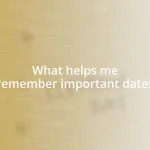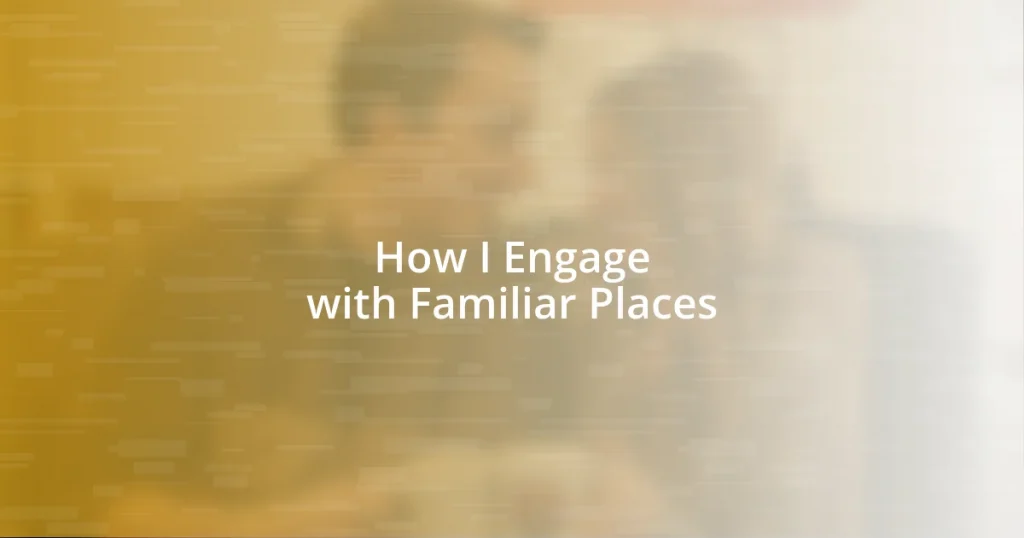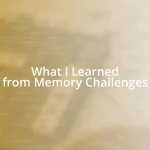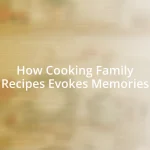Key takeaways:
- Familiar places evoke nostalgia and comfort, shaping our identity and influencing our experiences.
- Engaging deeply with familiar environments through techniques like journaling, exploring new routes, and mindfulness enhances emotional connections.
- Sharing experiences related to familiar places fosters deeper relationships and transforms personal memories into collective stories.

Understanding familiar places
Understanding familiar places goes beyond recognizing the scenery; it’s about the memories tied to them. I remember strolling through my hometown park as a child, where every tree seemed to hold a story. Have you ever noticed how just walking past a familiar corner can instantly flood you with nostalgia?
Familiar places often offer a unique comfort, serving as a backdrop to significant life moments. For instance, my favorite coffee shop isn’t just a place for caffeine; it’s where I celebrated milestones with friends and found solace during difficult times. Isn’t it fascinating how certain spots can feel like a second home, providing a sense of belonging?
In many ways, familiar places shape our identity and how we interact with the world. They form a canvas for our experiences, influencing how we perceive new environments. When you think of your own familiar spots, what stories come to mind? Each one is a chapter in your life that contributes to who you are today.

Benefits of familiar environments
Familiar environments can be incredibly beneficial for our mental and emotional well-being. I remember walking through my old neighborhood after a long day, and it felt like an embrace from a dear friend. Each familiar street, each brick and beam, reminded me of moments spent laughing with friends or simply enjoying the quiet. This sense of nostalgia can anchor us, providing a comforting escape from the chaos of everyday life.
Here are several benefits of familiar environments:
- Reduced Anxiety: Being in familiar places can help lower stress levels, as the brain associates these settings with safety.
- Enhanced Memory: Familiarity helps us recall past events and experiences, strengthening our personal narratives.
- Increased Comfort: These environments often provide a sense of belonging, making us feel more at home with ourselves.
- Strengthened Connections: They encourage social interactions, as revisiting familiar spots often leads to encounters with friends and acquaintances.
- Boosted Creativity: The comfort of familiarity can allow our minds to wander freely, often sparking new ideas and perspectives.

Techniques for deeper exploration
Finding deeper engagement with familiar places can be a rewarding journey. One technique I enjoy is deliberately taking different routes to explore areas I thought I knew. For instance, I once meandered through alleyways in my city that I had overlooked before. Discovering hidden murals and charming cafés transformed my perception, making the familiar feel vibrant and new. Have you tried altering your usual path? It might surprise you.
Another effective method is journaling your experiences in these spaces. After a short visit to my childhood playground, where I used to swing high into the sky, I took a few moments to write about what the place meant to me. Putting my thoughts on paper deepened my connection with those memories. I could relive those carefree moments and appreciate how they shaped who I am today. Have you ever considered documenting your reflections during visits to familiar places?
Mindfulness practices, like being fully present in a setting, can also enhance your experience. During a visit to my neighborhood library, I consciously focused on the sounds of pages turning and the soft light filtering through the windows. This simple act turned what was once a mundane task into a meditative experience, amplifying my connection to the space. How often do we rush through our familiar places without really seeing them?
| Technique | Description |
|---|---|
| Different Routes | Discover new aspects of familiar areas by exploring alternative paths. |
| Journaling | Document thoughts and memories associated with familiar places for deeper personal insight. |
| Mindfulness | Engage fully with your surroundings to enhance appreciation and connection. |

Engaging senses in familiar spaces
One of the most powerful ways to engage my senses in familiar spaces is through the aroma of the environment. I recall visiting my grandmother’s kitchen, where the scent of freshly baked cookies wrapped around me like a warm hug. This olfactory memory instantly transported me back to my childhood, evoking feelings of love and safety. Isn’t it fascinating how a simple scent can unlock such profound memories?
Sight is another sense that can deepen our connection to familiar spaces. Just the other day, I stood in front of the park where I used to play soccer with my friends. The vibrant hues of the flowers and the sunlight filtering through the trees brought back the exhilaration of those carefree afternoons. Can you remember a time when a familiar sight filled you with a rush of nostalgia? It’s moments like these that remind me of the beauty in everyday landscapes.
Touch often gets overlooked, but it plays a crucial role in how we connect with our surroundings. On a recent stroll through my old neighborhood, I ran my fingers along the weathered fence that bordered my childhood home. The rough wood under my fingertips stirred a cascade of emotions, linking me to my past. Have you ever paused to feel the textures of the places you hold dear? These tactile connections can reveal stories that words might struggle to express.
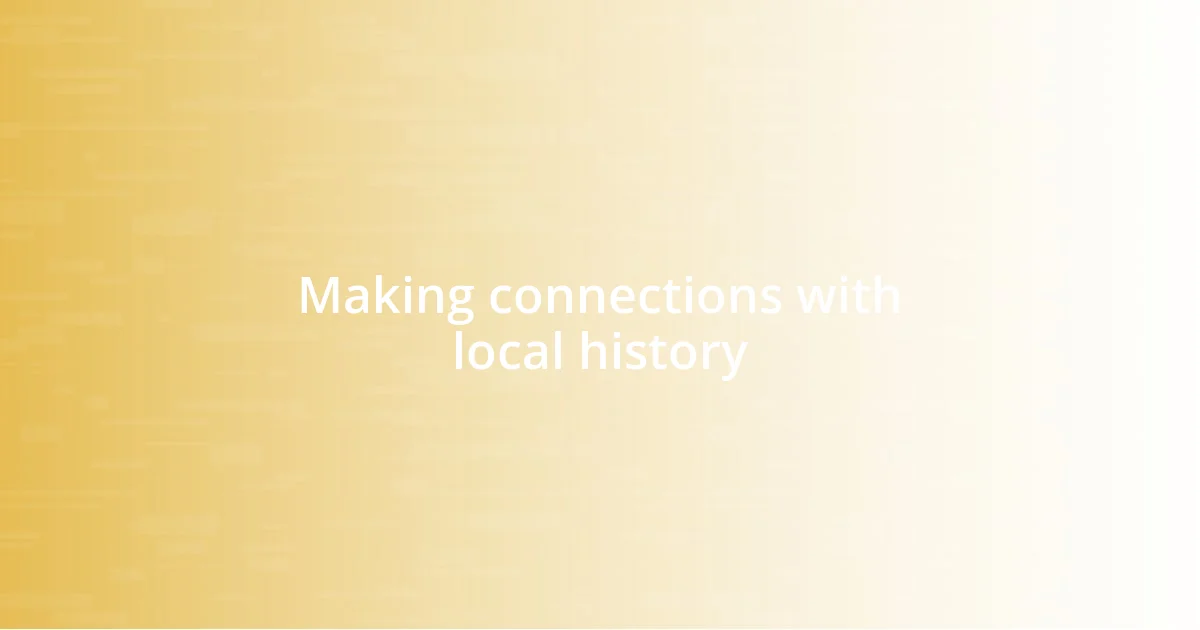
Making connections with local history
When I wander through my local park, I’m often reminded of the history that flows through its paths. Just last week, I stood by an old oak tree that my friends and I used to climb as kids. I found myself wondering about the countless families that have picnicked beneath its branches over the decades. Isn’t it incredible to think about the layers of stories held within a single tree?
I once took a guided tour of a historic neighborhood that has shaped my city’s character. As we strolled through the cobblestone streets, the tour guide shared tales of how these buildings survived wars and economic downturns. Listening to those narratives filled me with a sense of pride and belonging. Have you ever felt connected to a place when you learned its backstory?
Exploring local history isn’t just an intellectual exercise; it’s an emotional journey. A few months back, I visited an old train station that my grandfather once traveled from. Standing on that platform, imagining his excitement for a new adventure, I felt a wave of nostalgia wash over me. It hit me: our personal histories are intricately tied to these familiar places, bridging the past to the present. How often do we pause to reflect on the connections we share with our surroundings?

Sharing experiences with others
Sharing experiences with others can transform our personal memories into something collective and meaningful. I remember one summer evening when I gathered a few friends at my favorite lakeside spot. As we shared our stories about that place—tales of laughter, heartbreak, and discovery—we forged deeper bonds and painted a tapestry of shared experience that still warms my heart. Isn’t it interesting how talking about familiar places can deepen friendships?
Another time, while visiting an old café where I spent countless hours studying, I invited a new friend to join me. As we reminisced about our favorite dishes and the cozy atmosphere, I saw her eyes light up with excitement. It reminded me that sharing these familiar experiences can create new connections and memories. Wouldn’t you agree that experiencing the same space through someone else’s eyes adds a fresh layer to our understanding of it?
When I think about my childhood neighborhood and the moments spent with neighbors, I feel a rush of nostalgia. I often share these memories during casual gatherings, weaving in tales about the block parties we hosted and the games we played in the streets. As I recount those adventures, I’m reminded of the joy found in community and the simple power of storytelling. Have you ever noticed how sharing your experiences can turn a lone memory into a cherished narrative for others?






